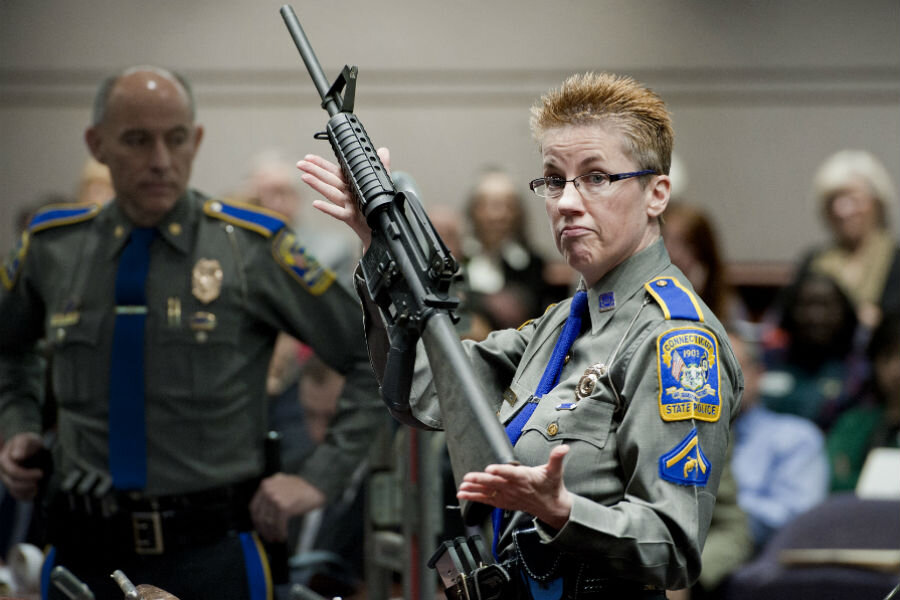Orlando attacks again raise questions about military-style rifles
Loading...
Sunday's news of a mass shooting at a gay nightclub in Orlando has restarted a familiar national conversation: Should military style rifles, used in mass shootings in Aurora, Sandy Hook, San Bernadino, and now Orlando, be banned?
While gun control proponents say rifles such as the AR-15 – the most popular rifle in the United States – are dangerous weapons designed to kill humans, guns-rights activists say banning the guns would be infringing on the rights of law-abiding citizens.
On Sunday, President Obama addressed the nation and said the shooting was "a further reminder of how easy it is" for someone to acquire weapons.
"And we have to decide if that's the kind of country we want to be," he said. "And to actively do nothing is a decision as well."
The gun used in the Orlando shootings, the AR-15 is used for protection, recreational shooting, and hunting according to the National Rifle Association, and is the most widely used rifle in marksmanship competitions and formal training. The NRA has staunchly opposed an assault rifle ban.
Richard Aborn, the president of the Citizens Crime Commission of New York City and a national expert on gun control legislation, tells The Christian Science Monitor assault weapons are inextricably tied to mass shootings.
"Assault weapons are military weapons designed for close-quarters combat," he says. "That's why you see them over and over and over again in these mass shootings. They are being used precisely the way they were designed: to slaughter people."
The last federal assault weapons legislation, which featured a 10-year ban on high capacity magazines and the manufacturing of such weapons, was signed by President Bill Clinton in 1994. The ban expired in 2004 and was not renewed.
In his 2013 testimony to congress, Wayne LaPierre, the executive vice president of the NRA, said the ban targeted a number of semi-automatic firearms, which are among the most popular guns "for hunting, target shooting and self-defense." He said studies "proved the ban had no impact on lowering crime."
Mr. Aborn disagrees, saying the assault weapon ban clearly reduced mass shooting casualties. Data provided from the Citizens Crime Commission states the number of people killed or injured in mass shootings during the decade of the ban decreased from 241 in the previous decade to 119 in the decade of the ban. That number tripled during the decade after, hitting 329 in September 2012.
Adam Winkler, a professor at the University of California Los Angeles school of law and author of "Gunfight: The Battle over the Right to Bear Arms in America," tells the Monitor the impact of 1994 to 2004 assault rifle ban is unknown. He says the ban was easy to get around by slightly altering the existing rifles. Mr. Winkler said data showed that the number of assault weapons found at crime scenes dropped during the ban, but there was no reduction in gun violence or fatalities, as assault weapons were used only in a small minority of gun crimes.
"The problems with assault weapons bans is it's hard to be very effective when there are so many easy substitutes," he said.
Winkler says handguns are more commonly used than assault weapons in mass shootings, and there are a lot of misconceptions about assault rifles.
"I think many in the public believe these are military weapons of war, that shoot like machine guns," he said. "In fact, they are intermediate powered rifles that are less powerful than many hunting rifles and only shoot one round of ammunition for every pull of the trigger, just like a handgun."
He says handguns can cause as much damage as assault rifles, as the size of the magazine is the crucial factor in determining the amount of damage.
"The goals we seek are not likely to be achieved by banning on particular type of weapon," he said.
A 2013 investigation into mass shootings by Mother Jones magazine found that 48 of the 143 weapons used in public mass shootings with more than four casualties between 1982 and 2012 would have been banned under the Assault Weapons Ban of 2013, which failed in the Senate following Sandy Hook, as The New York Times reported.
Aborn said although federal efforts to ban assault weapons and high-capacity magazines have failed, they have succeeded in some states. California, New York, Connecticut, Hawaii, Maryland, Massachusetts, and New Jersey all have assault weapon bans at the state level.
Winkler says gun control advocates should use whatever political capital they have from shootings like the Orlando shooting to push for laws requiring universal background checks, and increasing enforcement of the laws already on the books, specifically to empower the ATF to make it easier to crack down on rogue gun dealers.
Aborn says that it is too early to gauge what effect the increased dialogue in the wake of the Orlando shooting will have on possible legislation. But he thinks the nature of the shooting as a hate crime and increased knowledge of the success of the previous ban will increase the demand for the bill to be reinstated.
"I think you'll see more of a push for this ban to be reinstated," he said.







